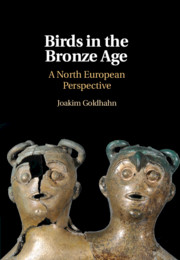Book contents
- Birds in the Bronze Age
- Dedication
- Birds in the Bronze Age
- Copyright page
- Contents
- Plates
- Figures
- Tables
- Lines of Flight: A Foreword
- Some Notes to the Reader
- Prologue
- Part I Lift-Off
- Part II Birdscapes
- Four Bronze Birds
- Five Birds for the Living
- Six Birds for the Dead
- Seven Birds on the Rocks
- Part III Intra-Actions
- Epilogue
- Book part
- References
- Index
- Plate Section (PDF Only)
Seven - Birds on the Rocks
from Part II - Birdscapes
Published online by Cambridge University Press: 10 October 2019
- Birds in the Bronze Age
- Dedication
- Birds in the Bronze Age
- Copyright page
- Contents
- Plates
- Figures
- Tables
- Lines of Flight: A Foreword
- Some Notes to the Reader
- Prologue
- Part I Lift-Off
- Part II Birdscapes
- Four Bronze Birds
- Five Birds for the Living
- Six Birds for the Dead
- Seven Birds on the Rocks
- Part III Intra-Actions
- Epilogue
- Book part
- References
- Index
- Plate Section (PDF Only)
Summary
This chapter deals with bird depictions that have been pecked and engraved in stone during the MBA and LBA in North Europe.2 Before we embark on this odyssey, it is important to underline that informed methods and historical sources have established that birds need not be depicted figuratively in order to constitute a vital part of the creation, use, and significance of rock art. Among Australian Aboriginals, for example, ancestors – some of them in the form of birds – often played a profound role in the creation of country, law, and cultural customs. There are more than 450 known Aboriginal creation stories related to birds documented through anthropological and historical sources, expressing how 116 bird species came about.3 Today, even more stories and myths are expressed and are waiting to be recorded. These creation stories are mediated through everyday practices and retold not only in informal conversations, but also as legends and myths.4 They are also enacted through songs, dance, body art, material culture, bark paintings, and sometimes also as rock art. Among other things, these stories embody certain events where ancestral beings created laws and customs before they were transformed into prominent landmarks, such as rivers, trees, cliffs, stones, ochers, land and sea animals, and birds.5 In some areas, ancestral beings in the form of birds are endorsed as the artists responsible for particular rock art images.6
- Type
- Chapter
- Information
- Birds in the Bronze AgeA North European Perspective, pp. 192 - 234Publisher: Cambridge University PressPrint publication year: 2019



